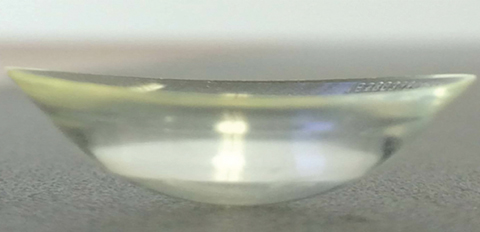 |
Q:
I just started fitting scleral lenses but haven’t yet ordered any toric peripheral curve lenses. My lab consultant mentioned that a majority of the orders she gets are for toric peripheries. Most of my patients seem happy and I rarely see much difference in lens edge appearance, but am I missing the point by not ordering toric peripheral curve lenses?
A:
“Following the rebirth of scleral lenses, symmetric landing of the lenses was the norm,” says Randy Kojima, a research scientist and clinical instructor at the Pacific University College of Optometry. “Most if not all designs came as a standard symmetric landing. At the same time, anterior segment OCT was being used to better understand the shape of the scleral 360 degrees around.”
According to Mr. Kojima, numerous studies performed at Pacific University have found the sclera to exhibit a toricity at 15mm of approximately 125µm. “When constructing sclerals with toricities of between 100µm and 150µm, the lenses appear rotationally stable in most eyes, suggesting we have improved alignment,” says Mr. Kojima. “Additionally, when patients are given the choice between the symmetric in one eye and the toric in the other, they will usually choose the toric as being more comfortable.”
 |
| Toric sclerals could help improve end-of-day comfort for your scleral lens patients. Click image to enlarge. Photo: Lynette Johns, OD |
Findings from both Europe and the United States have suggested that comfort, fit and physiologic response is improved when using sclerals with a toric landing, Mr. Kojima says.1-3 “Numerous larger lens designs greater than or equal to 16mm in diameter have made a toric back surface standard in their trial sets.”
Also citing scleral shape studies, Melissa Barnett, OD, immediate past president of the Scleral Lens Education Society, concurs.2-4 “There may be toricity in the sclera, irrespective of corneal toricity,” she says. “For lens diameters greater than approximately 16mm, back surface toricity may have certain advantages, including improved alignment on all meridians, reduced post-lens reservoir debris, better centration, less movement and improved comfort.”
To get a better idea of whether toric peripheral curve lenses would be beneficial for a patient, it may help “to evaluate the scleral lens fit outside of the slit lamp and using dim illumination and then with the slit lamp to look for areas of compression and impingement,” says Dr. Barnett. At the follow-up appointment, the cornea and conjunctiva should be evaluated for areas of staining after removing the scleral lens, Dr. Barnett adds. “Ask patients about their comfort with sceral lenses, especially end-of-day comfort. If any aspect of scleral lens wear could be improved, consider back surface toricity.”
“It appears the industry is moving from symmetric to toric as the lens of first choice in the larger diameter,” says Mr. Kojima. “However, studies show the closer to the limbus we land, the more symmetric the eye surface, so symmetric landing in scleral lens diameters of less than or equal to 15mm may be advisable.”
According to Mr. Kojima, researchers should further explore asymmetric scleral lenses, which may be “the way of the future.”
1. Schornack MM. Astigmatic correction with scleral lenses: A case series. Poster presented at the 44th Annual American Optometric Association Meeting; Philadelphia. |

